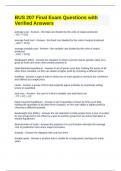Exam (elaborations)
BUS 207 Final Exam Questions with Verified Answers
- Course
- Institution
average cost - Answer-- the total cost divided by the units of output produced - AC = TC/Q average fixed cost - Answer-- the fixed cost divided by the units of output produced - AFC = FC/Q average variable cost - Answer-- the variable cost divided by the units of output produced - AVC = VC...
[Show more]



